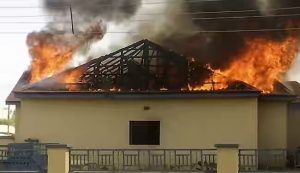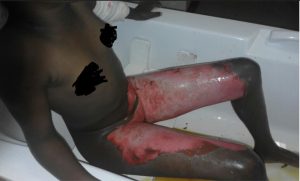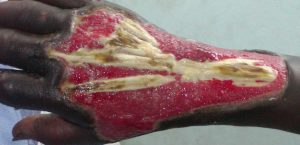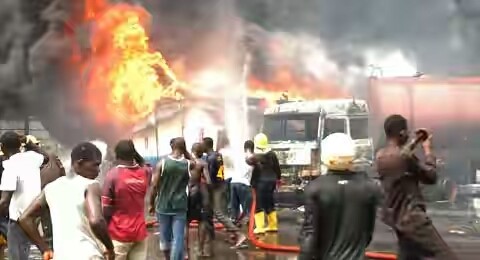First Aid is the initial help given to a casualty before or after taking him or her to the hospital for professional medical care. Saving lives is everybody’s concern – especially in the light of recent fire incidents across the country; the ability to carry out informed first aid decisions while attending to victims of accidents and emergencies can mean a difference between life and death.
Although fire is one of the necessities of life, it is a potential hazard and its outbreak is one of the causes of medical emergencies nationwide. Fire outbreaks could be natural, man-made, or both. Some of the causes of fire outbreaks include; Accumulation of combustibles like storing fuel in the house (during fuel scarcity), gas cylinder in the kitchen, use of candle lights, faulty vehicles, use of unapproved/cheap equipment like cables and wires, wiring running through the door, overloaded electric socket, wrong voltage fuse, unattended electric cookers/iron and the worse of all, Arson.

Fire outbreaks could lead to;
Loss of lives, properties, dent on the economy, and psychological effects on victims and survivors.
Burns: Fire can lead to all different degrees of burns depending on the severity. Burns can also be caused by hot liquids (scalding), electricity, chemicals, radiation (e.g. sunburns), etc. In burns, the affected cells are damaged and may die. Recovery depends on the severity and extent of cell damage and death, in addition, is the quick emergency response.
Burns could either be first, second, third, or fourth degree. In first degree burns, the top layer of the skin is affected and is usually red and un-blistered; the person recovers when the skin is shed and regenerated. In second- burns, the dermis is affected and there are blisters but it doesn’t extend to the subcutaneous tissue. In third-degree burns, all layers of the skin are affected including the subcutaneous fat. The degree is the worst kind; in addition to the third degree, it affects the tendons and bones of the area.
So, what are the roles of the first aider in handling fire outbreaks?
The role of a first aider in handling emergencies cannot be overemphasized. First Aid education and emergency management should be taught to all members of a community. The following are some ground rules that must be adhered to during fire outbreaks:
- Don’t Panic!
- Raise the alarm by activating the alarm system or shouting for help. And call the state fire service or any emergency contact person. Please get acquitted with the emergency numbers in your community.
- If the fire incident is happening in your house, office, or in a facility that you are at and familiar with, try switching off the main electric supply before leaving if you can.
- Don’t open the door if the doorknob is hot (use the back of your hand to feel it) or if you see smoke coming in from the bottom of the door. Please take note of this as many casualties have been burnt for not adhering to this instruction.
- If the door is not hot, open it slowly and be prepared to close it immediately if need be.
- Close all doors when there is a fire outbreak. Starve fire of air. Remember the fire triad – Oxygen, fuel, and heat. Close but don’t lock the door.
- Once out, stay out. Never go back.
- Don’t rush or push anybody when leaving a fire site.
- Don’t fight a growing fire alone.
- Never walk in the middle of a dark burning room. Walk from the sides of the wall to the available exit door. Be conversant with your room.
- Be conversant with any place you go to. Always note the available exit routes and whether there is a fire extinguisher or not. Learn how to use a fire extinguisher.
- Remember to stop, drop and roll if your clothing catches fire.

If you are a first aider/passer-by and you witness a fire outbreak from a building, bus, combustible products (like fuel tanks, pipelines, etc.), please do not go too close to the scene. Always check for your safety first. Assist any person in immediate danger to safety if it can be accomplished without risk to you. You can’t help a person by endangering yourself. It may result in two casualties instead of one. DON’T GO INTO A BURNING BUILDING IF YOU ARE NOT A TRAINED FIREFIGHTER WITH YOUR EQUIPMENT. DON’T GO INTO A BURNING CAR/BUS TO HELP A CASUALTY, IT MAY EXPLODE.
Always be calm and think clearly. Check for response. If you see someone on the ground (in a safe area), with eyes closed and looking lifeless, what are you to do? Bend down and start doing CPR? No. Call out, shout or shake casually by tapping their feet or shoulder. In a scenario where there was a pipeline explosion, the person lying lifeless may
have taken that stance to protect him. Always check for a response before anything else. If the person is not responding, shout and call for help – then follow the ABC of resuscitation.
A: Airways. Open the person’s airways by tilting the head and opening the jaw. You do this when the casualty is unresponsive and you are not sure the person is alright.
B: Breathing. After checking the airways and there is no obstruction, check for breathing. How will you know if someone is breathing? LOOK, LISTEN, and FEEL. Look towards the casualty’s chest for the rising and falling of the chest. Place your cheek and ear very close to the nose and feel for the warm air coming out of the person’s nose. Listen for about ten seconds and check if the breathing is normal or not by the way the chest rise and falls.
C: CPR. This is Cardiopulmonary Resuscitation, also known as Chest Compression. You do this after following the steps above and the casualty is not breathing. Place your hand straight on the xyphisternum (a end part of the mid area of the rib cage in the chest located between the lower border of the 2 breasts) of the person and your palm towards the nipple of the left breast. Then press 30 times, counting it. Check for breathing by placing your cheek and ear very close to the nose and feel for the warm air coming out of the nose while looking at the chest to see if it will “rise” and “fall” (showing breathing). Do this for ten seconds. If there is no response, do the compression again. Don’t do a mouth to mouth resuscitation. It is dangerous because you can contract a communicable disease like Hepatitis B. Remember, SAFETY FIRST.
½C: Check for pulse. You do this when there are many casualties to attend to. You have to know how to check for a pulse and know what is normal or not.

The role of a first aider in the management of burns:
What is the first thing that comes to mind when you see someone with a burn on the leg for example? Do you Call for help, Console the person and wait until the pain abates or administer some first aid treatment? When administering treatment, do you apply ice on the burn, or palm oil, or ordinary water? Management of burns depends on their severity.
For first degree burns, soak the wound or apply running water for longer than 7minutes. Give the person pain relief drugs. Don’t apply ice on the wound, it worsens it. Don’t place cotton wool on the burns. It sticks to it and peels out the skin during treatment.
In second degree burns, please do not break open the blisters. Apply running water for more than 10 minutes to soothe the pain. And give pain relief drugs. Remove jewelry or any restrictive materials if possible.
For third or fourth-degree burns, don’t attempt to treat. Call the emergency numbers/take the person to the hospital. Don’t remove clothes that are stuck to the body of a burns casualty.
According to the Federal Fire Service of Nigeria, about 185 lives were lost in 470 fire incidents in 2012 alone. This is in addition to varying degrees of burns sustained and damages to properties. These are just the ones documented, how much more those not reported. That is why everyone should have basic information on how to deal with fire emergencies. Everyone should be a first aider. It goes a long way in increasing the chances of survival in emergency cases.
Always prepare, prevent and be proactive.
Authors: Dr. Obi Mary Adaeze and Dr. Nwafor Ifechukwu
REFERENCES
1. www.icrc.org
2. www.redcrossnigeria.org
3. www.nema.gov.ng
4. http://www.peoplesdailyng.com/dealing-with-frequent-fire-outbreaks-in-nigeria/ Published Wed, 6th January 2016. Retrieved 23rd July 2016.
5. http://www.premiumtimesng.com/news/131841-185-people-die-in-470-fire-incidents-in-nigeria-in-2012-fire-service.html Published 29th April 2013. Retrieved 26th July 2016.
6. http://www.mayoclinic.org/first-aid/first-aid-burns/basics/art-20056649
7. http://www.healthline.com/health/burns.



